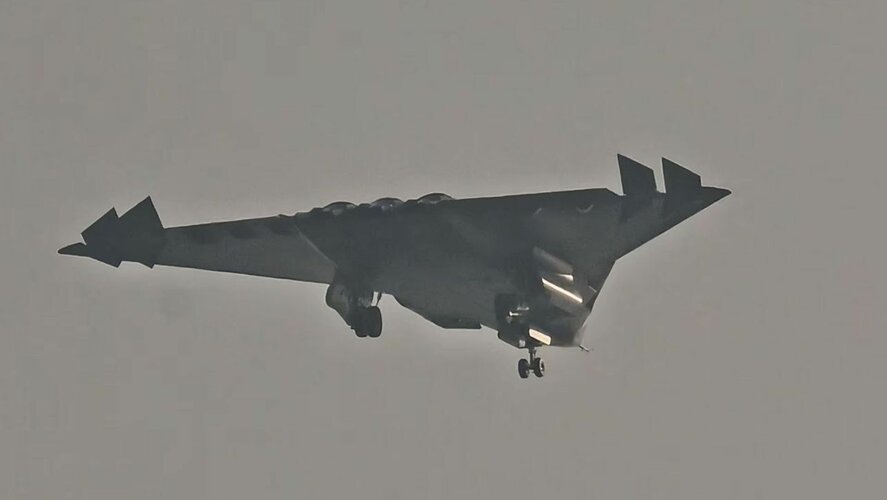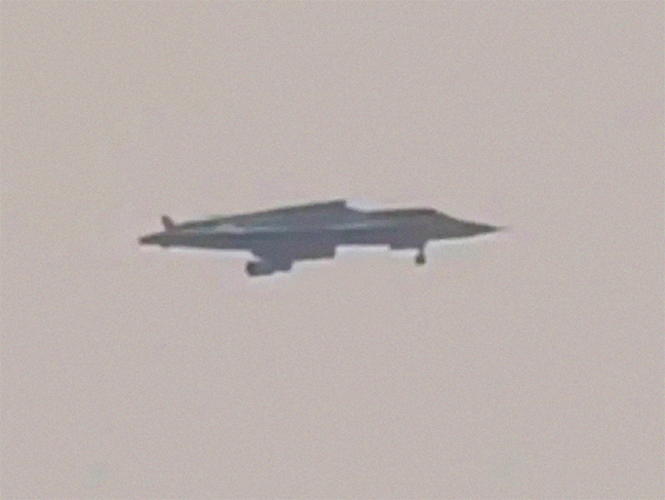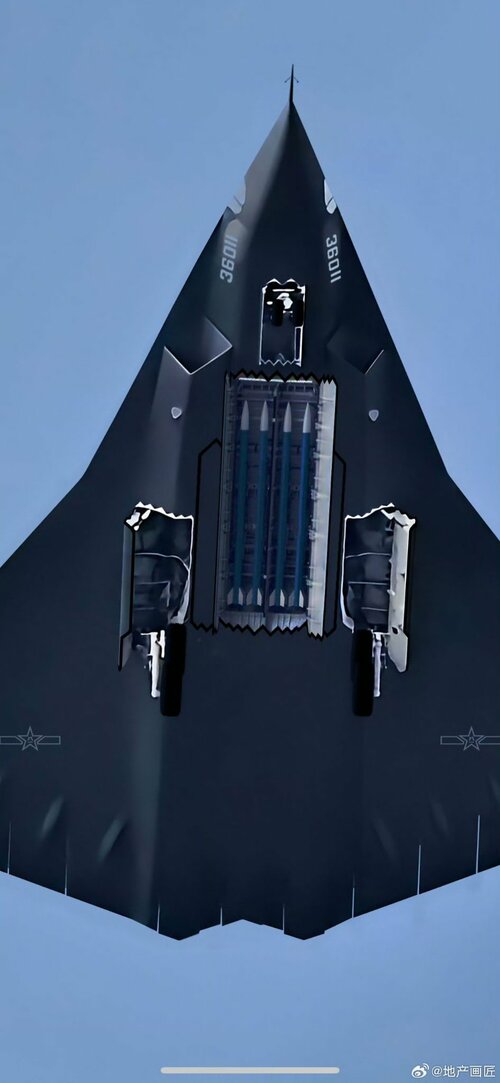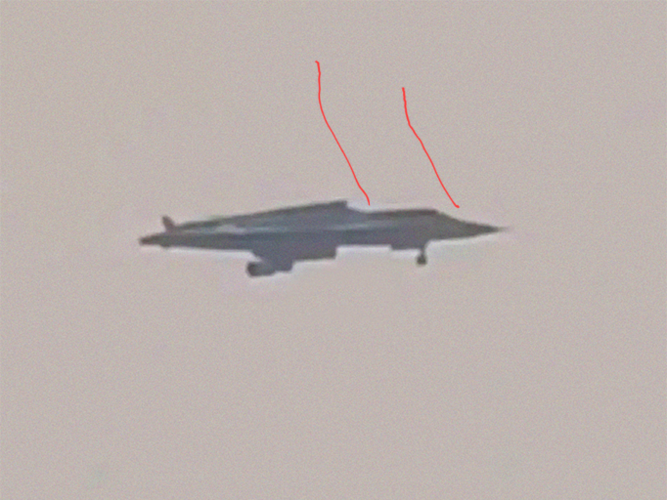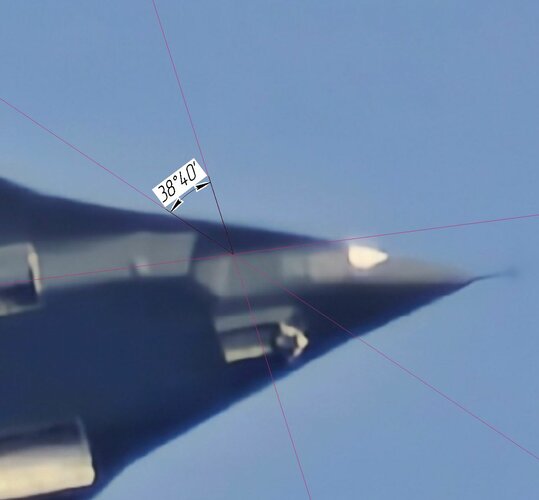Oh I see, so since it has similar intakes to the F22 it should be optimized for the same flight regimes too. That is assuming that there is no internal variable geometry mechanism, which due to complexity, weight, and radar reasons, is likely not present? Would the J-36 be able to maintain the same sort of supercruise as the F22 with less throttle due to my above mentioned properties, or is that something that cannot be speculated with the given information.Generally, the maximum speed estimates for tactical aircraft (without taking materials into consideration) are from several factors such as nose-to-wingtip angle, various sweep angles, and the inlet design. Regarding a fixed caret inlet as on the F-22, it is capable of efficient pressure recovery above Mach 2, but not significantly so without potentially running into performance or stability issues, or sacrifice efficiency in other parts of the envelope. Perhaps Mach 2.3-2.4 max. Beyond that you would need variable geometry features that can adjust the throat area, but that comes with its own tradeoffs in terms of cost, maintenance, and low observable characteristics. And the J-36 inlet, which appears to be a fixed caret type, appears to have more modest sweep angles.
Top supercruise speed is generally not something you can visually estimate, and for Ps=0 it also depends on the engine cycle and limits (compressor discharge, TIT, FTIT, etc). The only reason we know the F-22’s is that it’s been disclosed to be around Mach 1.8 or so at altitude (I believe Mach 1.76 on standard day, a tad faster on a cold day).
And yes the F-22 is placard limited at Mach 2 due to its RAM coatings, it has plenty of excess thrust at that speed and the structure can handle more. Per test pilot Jim “JB” Brown, at 40,000 ft the aircraft is using 118% throttle out of 150% available (for reference, 100% is full military power or dry thrust, 150% is full afterburner).
You are using an out of date browser. It may not display this or other websites correctly.
You should upgrade or use an alternative browser.
You should upgrade or use an alternative browser.
Shenyang / Chengdu "6th Gen" Aircraft - News and Analysis
- Thread starter tequilashooter
- Start date
I think its intended to supercruise at Mach 1.6 - 1.8 with maximum speed around Mach 2.0, Mach 2.3 absolute maximum (assuming variable intake geometry as suggested)
Agreed, likely WS-10 or WS-15 today and with a future 3 stream VCE that fits all the various platforms including J-20.
Read the articles I linked. I think they are following the (NGAD initiated) PCA model. PCA is intended to aggressively penetrate enemy airspace and destroy targets on the air and ground using it own weaponry and multiple CCAs. Think flying directly over Taiwan, targeting and destroying AWACS, SAM sites etc. It requires all-aspect stealth, which the J-20 doesn't possess.
In this example its mostly using off-the-shelf hardware to speed up development, again following the announced NGAD plan from a few years ago of rapid prototyping and iterating designs.
Yep, the Chinese articles I posted are sober enough about realistic use of technology, and explicitly call out that hypersonics would push things out to 2040.
I think you are overshooting the target in your interpretation of the next-gen fighter technology article you linked. I read it as a survey of requirements and solutions that pertain to the coming generation of combat aircraft, not necessarily as a description of any one particular design. I.e., most if not all tech that is present on the actual "J-36" will be contained in the document, but the converse is not necessarily true - I don't think you can safely assume that if it was described there, it will automatically be found on the "J-36". A bit like that radar blocker patent for the Su-57 which was available before we got the first images of the actual hardware on one of the late-stage prototypes. The device on the actual aircraft corresponded to one of the configurations described, but the patent included more alternatives, including for example a Super Hornet type solution.
That article describes an entire solution space, not the singular "J-36" design, as the older J-20 paper clearly did. For example, the caret inlets are pretty clearly fixed-geometry in this aircraft, there is no sign of the edges denoting the lowest ramp position which are so obvious in the Su-57. Even allowing, for argument's sake, the fact that image quality thus far is marginal and it might simply be lost in the noise and compression, the lip sweep angles define the greatest sweep back (corresponding to the highest free-stream Mach) of the initial oblique shock. And they are shallower than on the F-22 (in both planes) and Su-57 (at least in the plane with variable ramps, if not both).
Last edited:
Scott Kenny
ACCESS: USAP
- Joined
- 15 May 2023
- Messages
- 11,737
- Reaction score
- 14,524
Yes, but that stuff is eye-wateringly expensive.pretty sure the RAM on F-35 and F-22 rear engine blocker could easily sustain the intense heat
Cruising at Mach 3 puts your skin temperatures up to 400-500degF, based on published Blackbird info. That's the kind of temperature delta that modern sensors can track at hundreds of miles away.
"Hey, boss? I've got a hot thermal track with zero radar return."
Highly unlikely, it's too big a redesign. All of a sudden the plane is 5000+lbs lighter in the tail, just due to having one less engine. Plus you lose the dorsal inlet height/stability enhancement.Could it be interim until they have the proper engines for it? Then they will switch to 2 engines
Not enough information. Supercruise requires an engine that can tolerate a high compressor inlet temperature and has a relatively lower overall pressure ratio to limit turbine inlet temperatures. (And the lower OPR means less fuel-efficient)Oh I see, so since it has similar intakes to the F22 it should be optimized for the same flight regimes too. That is assuming that there is no internal variable geometry mechanism, which due to complexity, weight, and radar reasons, is likely not present? Would the J-36 be able to maintain the same sort of supercruise as the F22 with less throttle due to my above mentioned properties, or is that something that cannot be speculated with the given information.
For example, the Blackbird engines were limited to a compressor inlet temperature of 427degC, and the inlet alone was responsible for basically a 500degC temperature increase as it slowed the air down from roughly Mach 3.2 to subsonic and compressed it.
- Joined
- 27 December 2005
- Messages
- 17,768
- Reaction score
- 26,583
I wasn't actually suggesting this aircraft had variable intakes right now, just that if it was to have them fitted in future as per the article, it would still likely top out at Mach 2.3 at maximum.I think you are overshooting the target in your interpretation of the next-gen fighter technology article you linked. I read it as a survey of requirements and solutions that pertain to the coming generation of combat aircraft, not necessarily as a description of any one particular design. I.e., most if not all tech that is present on the actual "J-36" will be contained in the document, but the converse is not necessarily true - I don't think you can safely assume that if it was described there, it will automatically be found on the "J-36". A bit like that radar blocker patent for the Su-57 which was available before we got the first images of the actual hardware on one of the late-stage prototypes. The device on the actual aircraft corresponded to one of the configurations described, but the patent included more alternatives, including for example a Super Hornet type solution.
That article describes an entire solution space, not the singular "J-36" design, as the older J-20 paper clearly did. For example, the caret inlets are pretty clearly fixed-geometry in this aircraft, there is no sign of the edges denoting the lowest ramp position which are so obvious in the Su-57. Even allowing, for argument's sake, the fact that image quality thus far is marginal and it might simply be lost in the noise and compression, the lip sweep angles define the greatest sweep back (corresponding to the highest free-stream Mach) of the initial oblique shock. And they are shallower than on the F-22 (in both planes) and Su-57 (at least in the plane with variable ramps, if not both).
I think what has been built is mostly using mature J-20 technologies, with the possible exception of the control surfaces.
Characteristics of the J-36M serial version (J-36 demonstrator)
Length 20 m
Wingspan 21 m
Height 3.5 m (4 m)
The wing area is 174 m2
Volume 94 m3
The volume of weapon bays is 16.3 m3 (17.4%)
Weight:
Maximum 58,500 kg
Normal 38,500 kg
20,000 kg of fuel (in two hanging tanks in 10,000 kg weapon compartments)
Loads of 13,500 kg
Empty 25,000 kg
Engines:
Thrust 2 x 23100 kgf / 14250 kgf (3 x 15400 kgf / 9500 kgf)
Fuel consumption 0.57 kg/kgf*h (0.67 kg/kgf*h)
Maximum speed 2200 km/h (M-2.1)
Cruising speed 1800 km/h (M=1.7)
Flight range:
Subsonic 4,500 km (3,900 km)
Supersonic 2,900 km (2,500 km)
Subsonic with one tank in weapon bays 5,300 km (4,500 km)
Subsonic with two tanks in weapon bays 5,800 km (5,000 km)
Operational overload 6g
RCS 0.2 m2 (0.23 m2)
Total combat effectiveness 3.975
J-20 – 1.9, F-22 – 2.14, NGAD – 3.74, GCAP - 3.54, Su-57 – 3.24
Length 20 m
Wingspan 21 m
Height 3.5 m (4 m)
The wing area is 174 m2
Volume 94 m3
The volume of weapon bays is 16.3 m3 (17.4%)
Weight:
Maximum 58,500 kg
Normal 38,500 kg
20,000 kg of fuel (in two hanging tanks in 10,000 kg weapon compartments)
Loads of 13,500 kg
Empty 25,000 kg
Engines:
Thrust 2 x 23100 kgf / 14250 kgf (3 x 15400 kgf / 9500 kgf)
Fuel consumption 0.57 kg/kgf*h (0.67 kg/kgf*h)
Maximum speed 2200 km/h (M-2.1)
Cruising speed 1800 km/h (M=1.7)
Flight range:
Subsonic 4,500 km (3,900 km)
Supersonic 2,900 km (2,500 km)
Subsonic with one tank in weapon bays 5,300 km (4,500 km)
Subsonic with two tanks in weapon bays 5,800 km (5,000 km)
Operational overload 6g
RCS 0.2 m2 (0.23 m2)
Total combat effectiveness 3.975
J-20 – 1.9, F-22 – 2.14, NGAD – 3.74, GCAP - 3.54, Su-57 – 3.24
Last edited:
I wasn't actually suggesting this aircraft had variable intakes right now, just that if it was to have them fitted in future as per the article, it would still likely top out at Mach 2.3 at maximum.
I think what has been built is mostly using mature J-20 technologies, with the possible exception of the control surfaces.
Fair enough, I guess I didn't grasp the "if" sufficiently.
- Joined
- 27 December 2005
- Messages
- 17,768
- Reaction score
- 26,583
I wasn't clear. It was late at night!Fair enough, I guess I didn't grasp the "if" sufficiently.
Avimimus
ACCESS: Top Secret
- Joined
- 15 December 2007
- Messages
- 2,431
- Reaction score
- 912
In my personal opinion J-36 uses many solutions but not for aerodynamics, but stealth and in my opinion they have prioritized payload, if it is a fighter it is like MiG-31 a sniper, BVR as priority.
In my opinion, this is no dog fighter, it is an aircraft for BVR combat.
Reasonable enough. My question though: If it can pull 7 gees, does that make it a fighter? (thinking of your namesake in this case).
zebra159357
I really should change my personal text
- Joined
- 30 November 2018
- Messages
- 100
- Reaction score
- 278
What went into the calculation of this resulting value ?RCS 0.23 m2
Reasonable enough. My question though: If it can pull 7 gees, does that make it a fighter? (thinking of your namesake in this case).
If it can sustain that in terms of thrust/drag at corner speed rather than it being a single instantaneous turn, arguably so. Although for the F-14 and other carrier-capable fighters, 7g rather than 9 is a compromise in favour of cost and other requirements. I'm sure 9g would've been considered preferable. Of course, this aircraft might simply compromise on 9g capability to get more payload/range.
The MiG-31 is limited to 5g, IIRC.
The MiG-31 is limited to 5g, IIRC.
No surprise there given that it was designed as an interceptor and not an air-superiority fighter.
Waterballoon
ACCESS: Confidential
- Joined
- 27 October 2023
- Messages
- 116
- Reaction score
- 249
RuZZia stronk! Rest of Mir weak!What went into the calculation of this resulting value ?
BullpupRafale
ACCESS: Secret
- Joined
- 12 December 2021
- Messages
- 359
- Reaction score
- 463
You truly are contrarian in some regards.Characteristics of the J-36M serial version (J-36 demonstrator)
Length 20 m
Wingspan 21 m
Height 3.5 m (4 m)
The wing area is 174 m2
Volume 94 m3
The volume of weapon bays is 16.3 m3 (17.4%)
Weight:
Maximum 58,500 kg
Normal 38,500 kg
20,000 kg of fuel (in two hanging tanks in 10,000 kg weapon compartments)
Loads of 13,500 kg
Empty 25,000 kg
Engines:
Thrust 2 x 23100 kgf / 14250 kgf (3 x 15400 kgf / 9500 kgf)
Fuel consumption 0.57 kg/kgf*h (0.67 kg/kgf*h)
Maximum speed 2200 km/h (M-2.1)
Cruising speed 1800 km/h (M=1.7)
Flight range:
Subsonic 4,500 km (3,900 km)
Supersonic 2,900 km (2,500 km)
Subsonic with one tank in weapon bays 5,300 km (4,500 km)
Subsonic with two tanks in weapon bays 5,800 km (5,000 km)
Operational overload 6g
RCS 0.2 m2 (0.23 m2)
Total combat effectiveness 3.975
J-20 – 1.9, F-22 – 2.14, NGAD – 3.74, GCAP - 3.54, Su-57 – 3.24
bring_it_on
I really should change my personal text
- Joined
- 4 July 2013
- Messages
- 3,685
- Reaction score
- 3,902
Total combat effectiveness 3.975
J-20 – 1.9, F-22 – 2.14, NGAD – 3.74, GCAP - 3.54, Su-57 – 3.24
Interesting you got 3.74 for NGAD. My combat effectiveness analysis puts it closer to 4.17 and the Su-57 at 1.85 just below the J--20.. You should probably check your work.
BullpupRafale
ACCESS: Secret
- Joined
- 12 December 2021
- Messages
- 359
- Reaction score
- 463
Well could signify a 3rd prototype if like J-20's 2011.Can anyone speculate on the significant of the number '36011'
Sintra
ACCESS: Confidential
- Joined
- 7 April 2008
- Messages
- 73
- Reaction score
- 196
He used the "Eye-o-meter".What went into the calculation of this resulting value ?
Did you notice the "Total combat effectiveness" index? Love it to bits.
The bomber was supposedly being held up by engine development, if the J-36 really is using 3 based of WS-10 then they're still not ready on the next generation engines. There's also the potential that increased resources for these 2 fighter-size aircraft could me less available for the bomber, even China has limits.
The bomber likely requires a new engine of a completely different nature. Adopting fighter engines is not going to buy much more range whether it’s three or four. Also if the H-20 is subsonic, as is generally assumed, VCE/ACE serves little purpose.
Engine development seems to be the major limitation to timelines, and the use of an existing engine or family of engines skips over that with some penalties in efficiency and maintenance.
Last edited:
F-14ATomcat
ACCESS: Secret
- Joined
- 26 May 2024
- Messages
- 480
- Reaction score
- 915
I can not give you a very accurate answer because I do not have facts, it simply looks much bigger than J-20 and the landing gear suggest a very heavy weight.Reasonable enough. My question though: If it can pull 7 gees, does that make it a fighter? (thinking of your namesake in this case).
I just mentioned the XB-1 because it looks much more like a fighter than this J-36.
However since it is a big delta, I do not think its aerodynamics are as good, because usually delta wings need tails or canards, to improve, they have a tendency to bleed energy and drop turn rates very fast.
However i can not give accurate information just especulate.
Time will tell, but I hope the USAF has a better fighter and I hope the USAF prevails
- Joined
- 2 January 2006
- Messages
- 3,831
- Reaction score
- 5,171
Characteristics of the J-36M serial version (J-36 demonstrator)
Length 20 m
Wingspan 21 m
Height 3.5 m (4 m)
The wing area is 174 m2
Volume 94 m3
The volume of weapon bays is 16.3 m3 (17.4%)
Weight:
Maximum 58,500 kg
Normal 38,500 kg
20,000 kg of fuel (in two hanging tanks in 10,000 kg weapon compartments)
Loads of 13,500 kg
Empty 25,000 kg
Engines:
Thrust 2 x 23100 kgf / 14250 kgf (3 x 15400 kgf / 9500 kgf)
Fuel consumption 0.57 kg/kgf*h (0.67 kg/kgf*h)
Maximum speed 2200 km/h (M-2.1)
Cruising speed 1800 km/h (M=1.7)
Flight range:
Subsonic 4,500 km (3,900 km)
Supersonic 2,900 km (2,500 km)
Subsonic with one tank in weapon bays 5,300 km (4,500 km)
Subsonic with two tanks in weapon bays 5,800 km (5,000 km)
Operational overload 6g
RCS 0.2 m2 (0.23 m2)
Total combat effectiveness 3.975
J-20 – 1.9, F-22 – 2.14, NGAD – 3.74, GCAP - 3.54, Su-57 – 3.24
In fact this is still far off! Based on what Chinese posters say, hat "thing" is clearly larger / longer than 21 m !
Also, what engines did you chose in your calculation? And why two different settings one with two and one with three engines? This thing has clearly three and also any potential serial version will have three.
- Joined
- 21 December 2006
- Messages
- 1,246
- Reaction score
- 1,111
Looks like the top intake adds no effective 'fin' area, assuming CG is around where the main gear front wheels are.Surely not the clearest image of the J-36 yet, but the best one showing it from the side!
(via sus2024 / SDF) ... surely interesting for @paralay
View attachment 754076
I do wonder if it is fed using controlled vortices at higher AoA, like the HP115 (pic below), although it looks fairly level in the shot above.

- Joined
- 24 November 2008
- Messages
- 1,554
- Reaction score
- 2,627
From the paper @overscan (PaulMM) posted, apologies for the google quality translation:
Speaking of combat aircraft generations. Wouldn`t the application of "flexible deformation materials" and associated RAM one of the factors determining a true generational leap? Not only three-dimensional adjustable DSI-bumps (as proposed in the paper), but also morphing wings, control surfaces, fuel tanks and the like. That would be revolutionary. I think material technology isn't there yet, but what do I know.
The bulge formed by the inlet is even forward of the CG, aggravating any yaw divergence.Looks like the top intake adds no effective 'fin' area, assuming CG is around where the main gear front wheels are.
View attachment 754092
FlyGuy369
Flying is fantastic
- Joined
- 15 June 2023
- Messages
- 257
- Reaction score
- 701
siegecrossbow
I really should change my personal text
- Joined
- 12 March 2012
- Messages
- 731
- Reaction score
- 2,222
For those aeronautically inclined, theory time. For the top DSI, do you feel that it may be designed that way vice caret because the canopy is serving as a primary compression surface?
Isn’t the cockpit a bit too far for that effect?
BullpupRafale
ACCESS: Secret
- Joined
- 12 December 2021
- Messages
- 359
- Reaction score
- 463
We will find out if someone manages to make an accurate 3D model and see if that happens along at what speed it would start to do it.Isn’t the cockpit a bit too far for that effect?
The RCS values of several combat aircraft and missiles are known from the documents of the Russian air defense systems. For example, the RCS of a Su-27 without external suspensions is 5 m2, with a maximum combat load of 15 m2, the RCS of a cruise missile and an F-117 aircraft is 0.2 m2. "The RCS of a fifth-generation fighter cannot be less than 0.3 m2, due to its design features." Let's assume the minimum value for the F-22 is 0.3 m2.What went into the calculation of this resulting value ?
The next step is to select the formula and incoming data for these values. In the paralay-table, this is row 92-98.
paralay-tab
The calculation of "combat effectiveness" is achieved by comparing a group of parameters of a fighter with the Su-27 with the same parameters of the aircraft under study, an attack aircraft with the Su-24.
MiG has published an efficiency comparison for the MiG-29M
Let's compare their results with the tabular ones.
The MiG-29M surpasses the MiG-29 in air combat by 1.5 times, when working on ground targets by 3.8 times.
The F-18C surpasses the MiG-29 in air combat by 1.15 times, when working on ground targets by 3.75 times.
In the MiG-29 table, 0.856 and 0.484, MiG-29M 1.161 and 1.719, F-18S 0.976 and 1.751
MiG-29M surpasses MiG-29 1.161 : 0.856 = 1.36 and 1.719 : 0.484 = 3.55
F-18C surpasses MiG-29 0.976 : 0.856 = 1.14 and 3.62
1.5 or 1.36, 3.8 or 3.55
1.15 or 1.14, 3.75 or 3.62
that is, the table slightly underestimates the efficiency of aircraft, or is MiG overestimating, you can slightly adjust the coefficients.
It seems the CG underestimate the size of the weapon bay, and the engine nozzles can be refined, but still a good one
BullpupRafale
ACCESS: Secret
- Joined
- 12 December 2021
- Messages
- 359
- Reaction score
- 463
Better to underestimate than overestimate thus subsequently be disappointed.It seems the CG underestimate the size of the weapon bay, and the engine nozzles can be refined, but still a good one
- Joined
- 4 July 2010
- Messages
- 2,516
- Reaction score
- 3,107
I'm not saying the fighter and bomber would use the same engine, I'm saying if they're still on WS-10 derivatives for J-36 then their pace of turbine development has not advanced enough. They could build H-20 with a derivation of that architecture, it is after all reverse-engineered from a CFM turbofan, but that doesn't align with what they seem to be going for.The bomber likely requires a new engine of a completely different nature. Adopting fighter engines is not going to buy much more range whether it’s three or four. Also if the H-20 is subsonic, as is generally assumed, VCE/ACE serves little purpose.
Engine development seems to be the major limitation to timelines, and the use of an existing engine or family of engines skips over that with some penalties in efficiency and maintenance.
BullpupRafale
ACCESS: Secret
- Joined
- 12 December 2021
- Messages
- 359
- Reaction score
- 463
Perhaps intended maximum super cruise speed.It can be assumed that the air intake of the J-36 is optimal for a speed of M =1.67 / 1780 km/h
Entry angle F-22 - 34 degrees
Do you understand me correctly 
Now, with a wingspan of 24 meters and a length of 22.5 meters, we get a suitable volume.Surely not the clearest image of the J-36 yet, but the best one showing it from the side!
Attachments
Similar threads
-
-
Shenyang FC-31 demonstrators / J-35 naval fighter / J-35A land-based version
- Started by Foxglove
- Replies: 1K
-
-
-
Chinese test of Fractional Orbital Bombardment System
- Started by Flyaway
- Replies: 100

